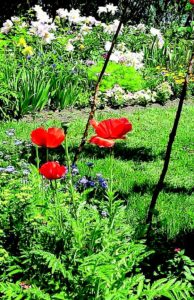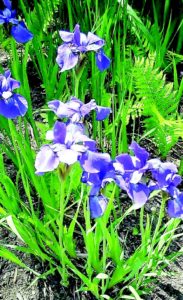Summer Solstice, 1992
It’s June, coming up on the Summer Solstice. The peonies are popping open in glorious reds, white and many-petaled pinks. We had are first ‘Sugar Snap’ peas last night in a stir-fry. Sturdy, breathtaking catawhiense album rhododendrons and fragrant Rugosa roses line the way to pick rhubarb for pie. Suzanne combines its red stalks and just ripe strawberries with delicious results.

Peonies and poppies signal the start of summer.
Pale blue and deep purple irises and dark blue lupine blossoms float above verdant spring growth. The tiny flowers on the native raspberries are fertilized and swelling.
Crisp, frilly lettuce in reds and greens grows faster than we can pick it; spinach, arugula, dill cilantro and oregano are flavorfully abundant.
The sun’s altitude is slowly nearing its highest of the year. This is the time of the midnight sun above theArctic Circle, which for us produces the long twilights which make our cool mornings and fecund evenings so wonderful.
At our home, an overhang on the large south-facing windows keeps the sun out of the house now. These are the same windows which let the low sun shine all the way to the back of the house in the winter. When I told the insurance agent that our house had solar heat, he asked how many panels we had, wrongly believing that if we had solar heat, we mush have panels. I told him about the windows, but he still didn’t believe me.
Trees to the east and west of our house leafed out quickly in late May. Now they provide cool shade from the hot morning and afternoon sun. Trees are beautiful, quiet, chlorofluorcarbon-free, solar-powered air conditioners. They don’t need a nuclear power station or a large dam to work, and they remove carbon dioxide from the air.
The solar clothes dryer we use in the winter is on the protected south side of our house. That is now in shade, so we’ve moved the clothesline to the sunny north side where the garden is. The high angle and long path of the sun make the area north of the house sunny from the spring to the fall equinoxes. This period, from March 20 to September 22 (in 1992) is the primary growing season.

Deep purple irises float above verdant spring growth.
I’ve just described, and have used for decades, The Big Four Low-Cost, Ready-to-Use Solar Collectors, Designed for a Better Tomorrow – the garden for food, trees for cooling, south-facing glass for warmth, and a clothesline. They are inexpensive, dependable and widely-available. Like strawberries, rhubarb and the perennial flowers, these solar solutions are long-lasting, pleasant to care for and live with, and easily maintained. They can work as well on a small lot in the city as they do in rural areas, and provide nearly unlimited possibilities for satisfying, productive work.
In contrast, a new, Sunwood development home nearby, given a “Good-Cents” rating by the local electric utility, has only one small window on the south side and no trees to shade the east and west windows from the summer sun.
Building codes require electrical outlets every so many feet along each wall of a house. Although this is supposed to be for the public good, it probably is of more benefit to the banks, insurance companies and appliance manufacturers. The building code contains no requirements for planting shade trees or for orientation to the sun.
The pleasures of the garden and other solar solutions provide strength and inspiration for the educating and healing we must do. This solstice, let’s start creating in our local environments the kind of world we can enjoy living in all over the Earth.
Living on the Earth: Eclectic Essays for a Sustainable and Joyful Future includes essays from the first three of the ten years that Living on the Earth essays were aired weekly on public radio fromFairfield,CT. The essays were written by Bill Duesing and edited by Suzanne Duesing.

